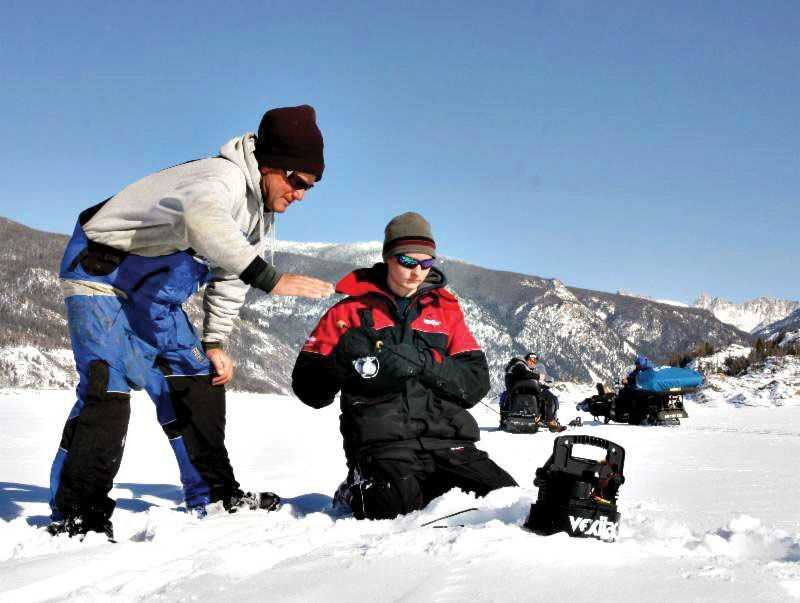
Lake trout are hard-fighting, fine-tasting quarry worthy of ice anglers’ serious attention, yet many hardwater warriors shy away due to the intimidation factor. After all, finding and fooling mobile, moody wintertime trout borders on the impossible for all but seasoned experts, right?
Hardly. Just ask veteran guide and longtime laker (this means lake trout for the uninitiated) fan Bernie Keefe, who helps scads of aspiring trout bums connect with stellar icewater catches.
“If people are intimidated, they shouldn’t be,” he said. “By following a few basic principles of location and presentation, it’s possible for even first-timers to put fish on the ice.”
Putting yourself on a solid fishery is job one. It’s accomplished easily enough by querying state fishery biologists, local guides and bait shop regulars, as well as monitoring the chatter on Internet fishing forums. Keefe spends much of his time on high-country Colorado gems like Granby, Shadow Mountain and Grand lakes, but options abound in a number of states and Canadian provinces.
Once you’ve settled on a promising honeyhole, zero in on productive areas. “In winter, lake trout can mostly be anywhere they want to be,” Keefe began. “Lake-wide, the temperature is right in their wheelhouse. Same goes for the water column. It’s 39 degrees at the bottom and 32 on top, so suspended fish are not uncommon.”
Still, there are mitigating factors. In mid to late winter, oxygen depletion in deep water often pushes trout higher in the column, so it’s possible to eliminate extreme depths when this occurs. “February into March, you’ll see a lot of fish moving up, suspending 50 feet down over 100 feet or more of water,” he said.
In a structural sense, Keefe often follows a point or ridge from shore into deeper water. “Sometimes you find them by veering off the structure halfway out, and other times by following it to the end, then walking a little farther out over the abyss,” he explained. “It sounds funny, but they like being in the middle of nowhere, yet close to some type of structure.”
Since trout are cold-water eating machines, Keefe keys on areas with ample forage. “Fifteen- to 20-plus inch lakers, the ones easiest to catch and the best to eat, have predictable feeding habits,” he said. Favorite food for these size lakers in Keefe’s core lakes include Mysis shrimp, plankton and small minnows. In other systems, the menu includes a variety of insects, plus ciscoes, smelt and other fare. Large trout, which are always a possibility, favor bigger meals, and aren’t above cannibalizing other salmonids, including juvenile lake trout. In systems offering a bit of current, Keefe checks places where the flow concentrates forage, thereby condensing the food chain into smaller areas.
To speed your search, he suggested tapping easy-to-access areas adjacent to community holes. “In the Rockies, walking out from roads and ramps often lands you over 60 to 100 feet of water in a hurry,” he said. “Find a spot where the mob has been fishing, and either follow the same depth contour parallel to shore, or move out a little deeper.”
Unlike ice fishing for many other species, where marking fish with sonar is important before fishing, trout are such cruisers that it takes a bit more faith. After dropping his Vexilar sonar transducer into a hole, he lowers a beefy jig into the water and methodically works down the water column with slow and steady jig-strokes. “Once you hit bottom, bang it a few times, then start back up,” he said.
Go-to jig heads include Lazer TroKar’s #810 jig hook. Tippings trend toward softbaits like a 3- to 4-inch Berkley Gulp! Minnow, or 2- to 3-inch Lindy Fuzz-E-Grub, tube or similar softie. “Choose contrasting jig and softbait colors,” he noted. “I like orange, chartreuse or black for the head, and white for the trailer.” He also skewers a small slice of succulent sucker meat on the hook for added attraction, no longer or wider than the jig.
While jigging, Keefe eyes his sonar screen, which is set to cover the entire column. “Watch for marks coming in,” he said. “When you see a fish, get your jig to that level and experiment with pauses, shakes and raises until you figure out what they want.” Since most strikes occur on the fall, Keefe keeps a tight line throughout the presentation. And when a fish strikes, he sets immediately. “The second they feel the jig, they look up at you, open their mouth and shake their head violently,” he said. “If you don’t have them hooked good and keep the line tight, they’re gone.”
Keefe said an ice rod with a stout backbone yet somewhat forgiving tip is ideal for hooksets and battles. He uses a 36-inch, medium-heavy Dave Genz split-handle rod from Clam Outdoors spooled with 10-pound-test Berkley Trilene 100 Percent Fluorocarbon.
He advises reeling trout slowly to the surface to reduce the chances of post-release mortality. On lakes with healthy trout populations, keeping a few smaller fish yields delicious table fare. Keefe suggests immediately bleeding out trout to improve their flavor. Following his advice, it’s possible for even novice ice fans across lake trout territory to crush the intimidation factor. If you’re reading this from afar, it might convince you to give it a try and see what all the fuss is about.
By Dan Johnson
For more information or to book a trip with Keefe, visit fishingwithbernie.com or call (970) 531-2318.
